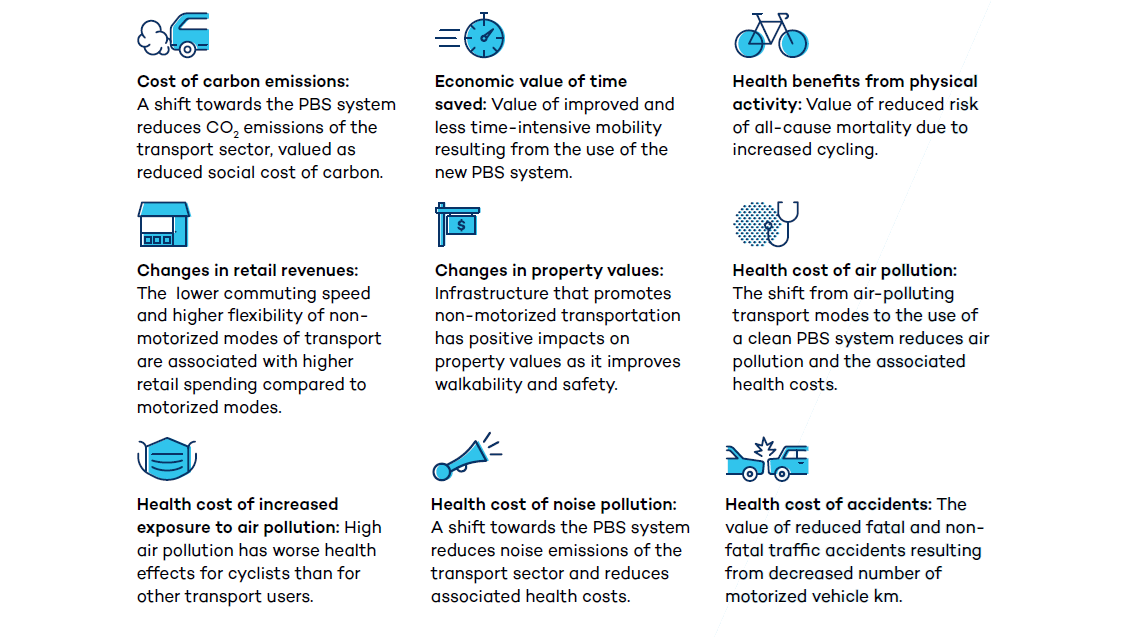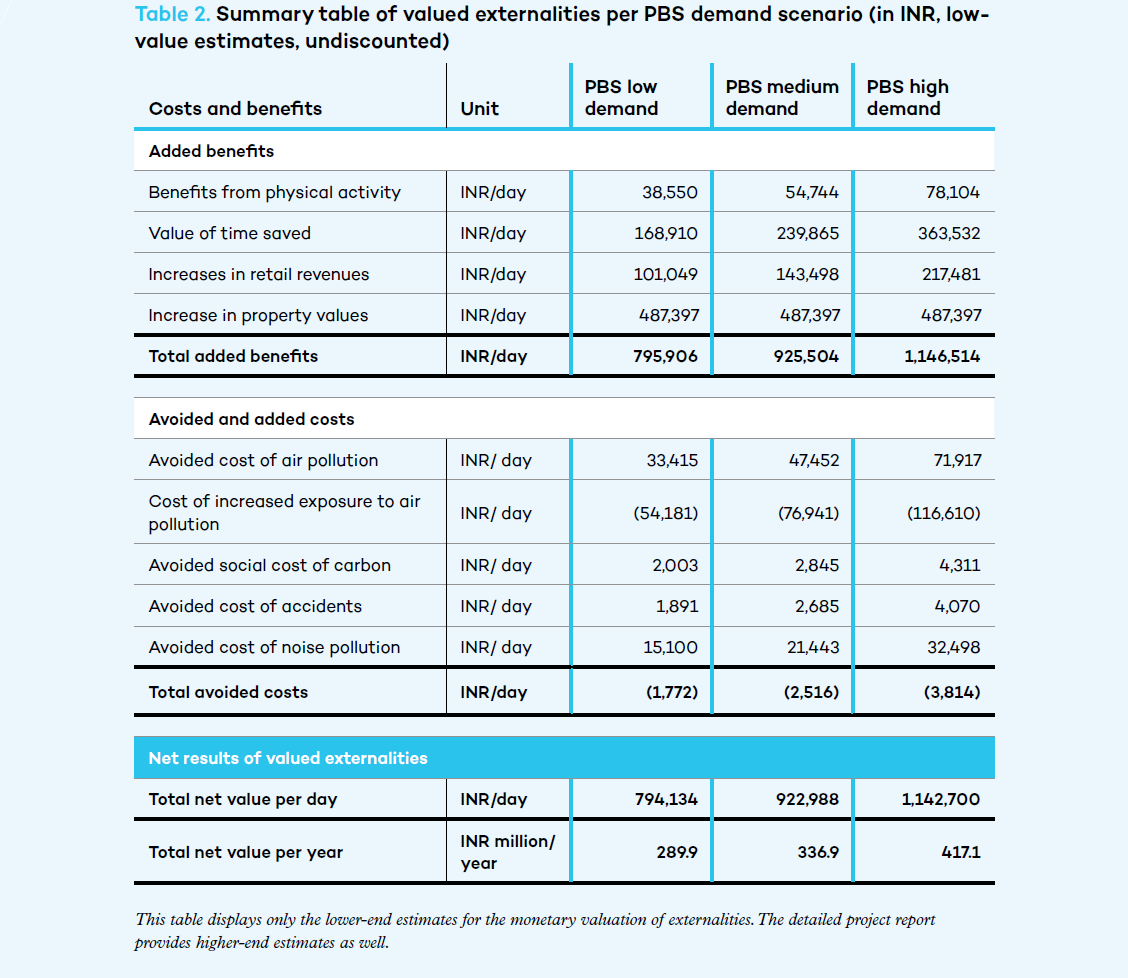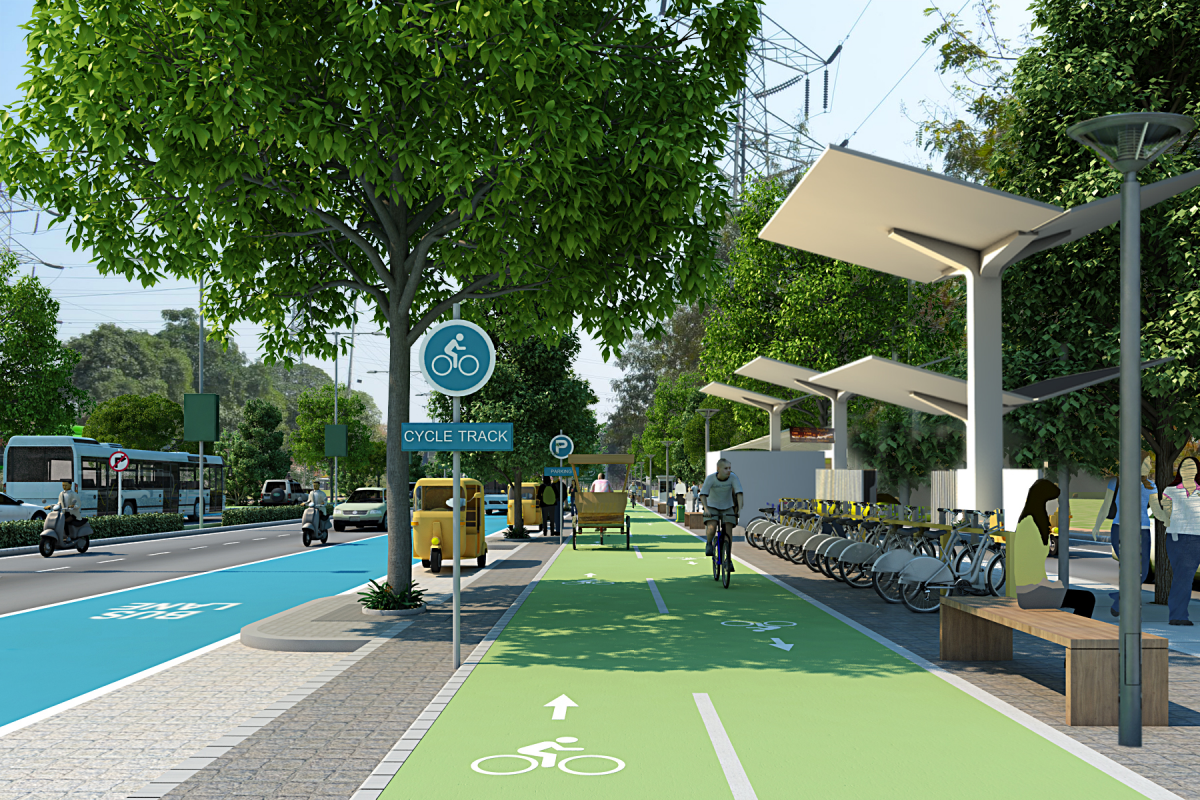The SAVi assessment of the Public Bicycle Sharing (PBS) System in Dwarka is now complete, with the final report and brochure published in January 2020 and available online.
The Centre for Green Mobility—which is currently developing an implementation program for a Public Bicycle Sharing system in New Delhi—asked IISD to apply the SAVi methodology to assess the benefits of a well-implemented PBS system. This quantitative evidence is crucial for strengthening the business case for the PBS system as well as encouraging public authorities to invest in providing the necessary bicycle lanes and safety infrastructure. SAVi was customized to estimate and value the environmental, social and economic co-benefits and avoided costs generated by the PBS system.
The SAVi assessment consists of the following elements:
- A valuation of nine externalities resulting from a successfully implemented PBS system.
- A comparison of three demand scenarios and the scale of their valued externalities.
- An integrated cost–benefit analysis of the PBS system, including valued externalities per demand scenario.
The assessment demonstrates how and to what extent the PBS system can improve the quality of life in Dwarka, a sub-city of New Delhi. It also shows how the system can contribute to achieving the sustainable mobility targets described in the Delhi Master Plan 2021, a set of policy objectives prepared by the Delhi Development Authority that target issues such as the under-provision of transport infrastructure services and the need for improved environmental conservation.
Moreover, the cost–benefit analysis conducted in this SAVi assessment provides benchmark values of appropriate and optimized investment volumes for sustainable transport infrastructure in Dwarka. This includes bicycle lanes and additional road safety elements to make the use of the PBS system viable and realize the associated benefits. The calculated SAVi net results (Table 3) represent the societal value that the PBS system could deliver in Dwarka if desired demand for the system is realized. These SAVi net results provide a reasonable starting point for public sector decision-makers to determine the maximum monetary amount that infrastructure components could cost over the course of 20 years.
Scenarios
Three potential demand scenarios were considered in this SAVi assessment, reflecting the difficulty of forecasting demand for potentially transformative public transportation projects. Each scenario implies a shift in mobility patterns from other modes of transport to the use of PBS-provided bicycles. The modes of transport that would face reduced demand are buses, cars, motorcycles, auto rickshaws, pedal rickshaws and walking. This table indicates the mobility shifts toward the PBS system for each demand scenario.

Externalities
The analysis takes the following externalities into account:

Results of the SAVi Assessment
The valued externalities that were generated per demand scenario are displayed in the table below. The results are indicated as daily monetary values relative to a baseline scenario that does not involve a PBS system. The externalities are categorized into “added benefits” and “avoided and added costs.”
The scale of the monetary value per externality depends on demand for the PBS system and the associated shift away from other transport modes. Higher demand translates to higher net value. In each scenario, the total value of positive externalities clearly outweighs the value of the only negative externality, which is the increased direct exposure to air pollution faced by new cyclists. The largest benefits stem from the economic value of time saved, the increases in retail revenues and property values, and the avoided costs of air pollution.

SAVi’s Integrated Cost-Benefit Analysis
The table below displays the results of an integrated cost–benefit analysis conducted for the PBS system. The conventional net results indicate that the PBS system falls short on financial performance under all demand scenarios. However, if the environmental, social and economic co-benefits and avoided costs valued by SAVi are integrated, the picture changes significantly. The SAVi net results demonstrate that each demand scenario yields a positive net value. The higher the demand for using the PBS system, the higher the positive net result.
Even when assuming conservative demand numbers and lower-end estimates for the valuation of externalities, discounted net benefits over 20 years amount to more than INR 3.14 billion (~USD 44.4 million). The more optimistic high-demand scenario would yield a net result of INR 4.82 billion (~USD 68.2 million). These SAVi net results also indicate benchmark values for making public investment decisions for providing bicycle lanes and additional road safety elements to make the use of the PBS system in Dwarka viable.

Conclusion
The SAVi assessment results provide clear evidence that the PBS system is a worthwhile investment. It advances the realization of sustainable mobility targets in Dwarka, improves quality of life and helps deliver on transport policy objectives defined in the Delhi Master Plan 2021. Positive implications of the PBS system include its contribution for convenient and affordable access to public transport, along with related facilitation of multi-modal transport use, enhanced transport efficiency, reduction of carbon emissions, positive health effects (resulting from reduced air and noise pollution), and more road space for cyclists with associated benefits for retail spending and property values.
The SAVi assessment strengthens the business case for the PBS system and encourages public authorities to invest in providing bicycle lanes and traffic safety infrastructure in Dwarka. This SAVi assessment also showcases the importance of systemic and integrative assessments for demonstrating the real value of sustainable mobility projects and for allocating public investments accordingly.
The Centre for Green Mobility is making use of the SAVi assessment results in conversations with public authorities in India, including the Delhi Development Authority, to promote the implementation of this and other PBS systems in India. IISD is pleased to support the deployment of sustainable mobility projects and looks forward to providing advice and conducting further analyses on the sustainability value and financial viability of transport infrastructure projects in India.
